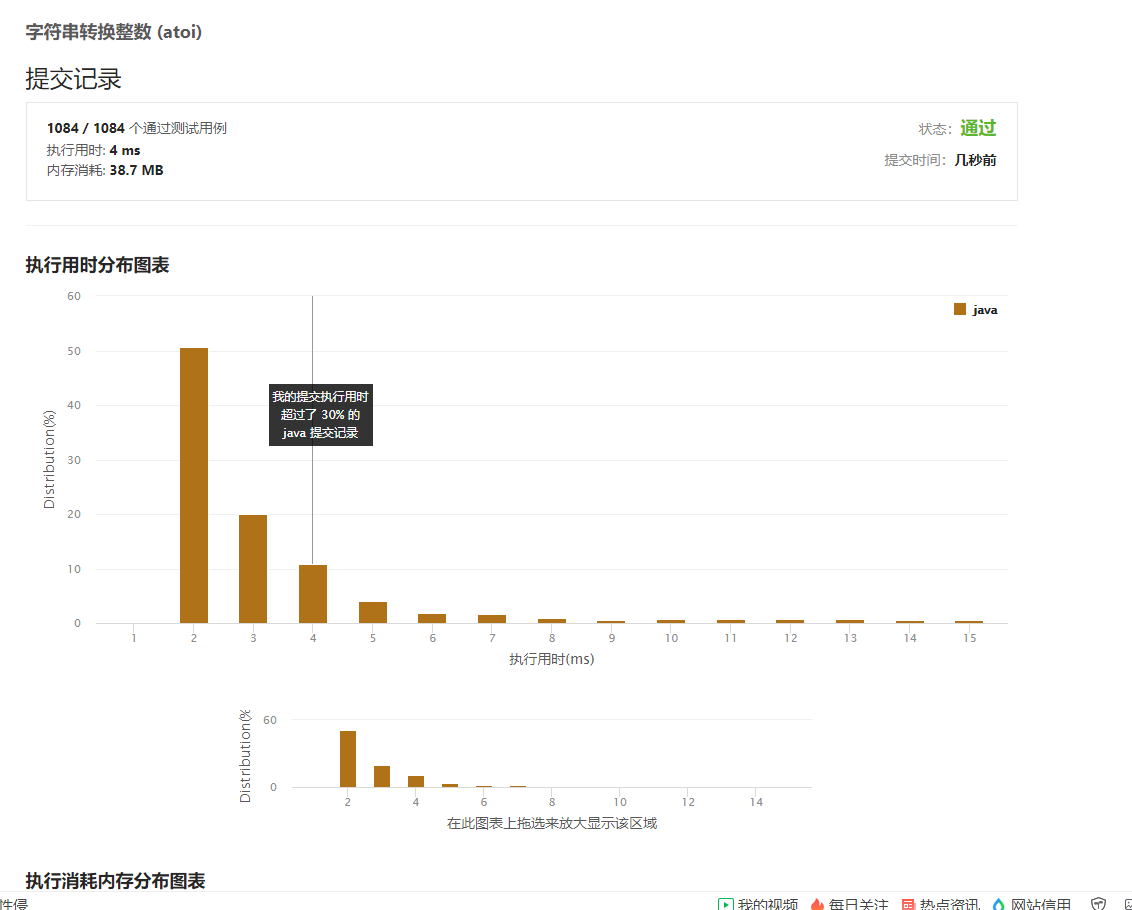LeetCode题解——字符串转整数(atoi)
我的LeetCode代码集:https://github.com/cnamep001/LeetCode
原题链接:https://leetcode-cn.com/problems/string-to-integer-atoi/description/
题目描述:
知识点:字符串
思路:顺序遍历字符串,根据题意读取整数
对于这一题来说,难点不在算法的实现上,难点在理解题意并正确处理各种边界或者特殊情况上。
(1)如果第一个非空字符是正号或负号,选取该符号,并将其与后面尽可能多的连续的数字组合起来,这部分字符即为整数的值。
(2)如果第一个非空字符是数字,则直接将其与之后连续的数字字符组合起来,形成整数。
(3)如果第一个非空字符既不是正号或负号,也不是数字,返回0。
(4)如果字符串为空,或者字符串内只包含空字符,返回0。
(5)如果第一个非空字符是正号或负号,但接下来的第二个字符不是数字,返回0。对于"+-2"、"+ 2"这两种情况,都返回0。
(6)如果数值超过可表示的范围 [−2^31, 2^31 − 1],则返回 INT_MAX (2^31 − 1) 或 INT_MIN (−2^31) 。实现时用Integer.valueOf()函数抛出的异常来判断整数越界。
注意:字符比较要用"==",但字符串比较要用equals()方法。
时间复杂度和给的字符串中第一个空白字符出现的位置,以及其后或者第一个正负号其后连续的数字个数有关,但一定是小于O(n)时间复杂度的,其中n为字符串的长度。空间复杂度和时间复杂度相同。
代码如下:
package com.m.string_to_integer_atoi;
public class Solution1 {
public int myAtoi(String str) {
int n = str.length();
int i = 0;
while(i < n && str.charAt(i) == ' ') {
i++;
}
if(i == n || !((str.charAt(i) == '+') || (str.charAt(i) == '-') ||(str.charAt(i) >= '0' && str.charAt(i) <= '9'))) {
return 0;
}
StringBuilder stringBuilder = new StringBuilder();
if(str.charAt(i) == '-') {
stringBuilder.append('-');
i++;
}else if(str.charAt(i) == '+') {
i++;
}
if(i == n || !(str.charAt(i) >= '0' && str.charAt(i) <= '9')) {
return 0;
}
while(i < n && str.charAt(i) >= '0' && str.charAt(i) <= '9') {
stringBuilder.append(str.charAt(i));
i++;
}
try {
return Integer.valueOf(stringBuilder.toString());
}catch (Exception e) {
if(stringBuilder.substring(0, 1).equals("-")) {
return Integer.MIN_VALUE;
}else {
return Integer.MAX_VALUE;
}
}
}
}
LeetCode解题报告:

测试代码:
package com.m.string_to_integer_atoi;
public class Test1 {
public static void main(String[] args) {
String [] strings = new String[]
{" 42 "," -4 2", " 4 hello 2 world","hello 42","-91283472332"};
Solution1 solution1 = new Solution1();
int temp;
for (int i = 0; i <strings.length ; i++) {
System.out.print("字符串是:"+strings[i]+" ");
temp = solution1.myAtoi(strings[i]);
System.out.println("结果是:"+temp);
}
}
}
